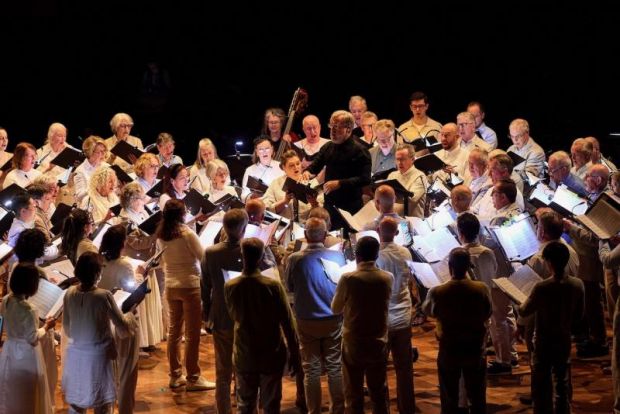Vespers
Brett Weymark described this interpretation of Rachmaninoff’s Vespers as “a special performance that sits somewhere between ritual, concert and theatre”. It is indeed special – because Weymark had the vision of the choir moving into different formations signifying the four phases of the All-Night Vigil of the liturgy: sunset to night, through the night to dawn and the new day – Vespers, Compline, Matins and the First Hour.
How he achieved this is typical of Weymark’s inspiration and drive!
Imagine the Town Hall cleared of seats. Imagine a square in the centre of that space marked out by clusters of candles and fresh cut flowers. Imagine the remaining floor space laid with lines of yoga mats where some of the audience, like those in older times, would wait out the long night.

A transformation had occurred. Weymark had worked his magic.
As the light dimmed slightly, Anthea Cottee and James Beck with their cellos, and David Cooper and Jennifer Penno with their Double basses took their places in chairs in the centre of each side of the square. They would play the music Weymark composed to intertwine the movements of Rachmaninoff’s work.
From doors on the north and south walls of the hall came the choir in soft whites and creams, their faces illuminated by the soft lights of their songbooks. On a movable rostrum conductor Tim Cunniffe raised his baton… and the Vigil began.
It is hard to describe in a short review the effectiveness of Weymark’s direction and the skill with which the choir moved so adeptly.

At times they created a diagonal corridor through which soloists mezzo-soprano Hannah Fraser moved as they sang. At others they moved to pairs of parallel lines along each side of the candle-lit square. Once they moved out of the space and formed single lines along the stairs to the pipes of the organ and along the front of the raised stage. At another time they formed small circles of six to ten, facing each other, yet acutely aware of their conductor’s signals – especially as he also was carefully moved to different places on the ‘stage’. How unusual to see a choir moving, and with such calm control!
Each section of the Vigil was gently introduced by Weymark’s interludes, the notes of cello and the deep voice of the double bass echoing the deep resonance of Rachmaninoff’s skillful blending of old Russian chants and melodies and the more expressive music of the early twentieth century.As Rachmaninoff’s musical messages led them toward morning, some members of the choir began to move slowly out of the hall, while others carefully bent to pick up candles and place them in a sun-like cluster on the southern side of the ‘stage’. Saxophonist Nicholas Russoniello came down from where he had played earlier in the Vigil to stand beside that flickering ‘sun’ until the last chorister had disappeared. Then, out of the stillness and silence, the Hymn to the Mother of God – The First Hour – began, sung, symbolically, outside in the foyer, heralding the new day.

Just as it had highlighted the differing tones of the music, the movement of the choir and the passing day, Mark Hammer’s subtle lighting haloed the candles as their light and the last notes of the choir promised renewal. Hammer used mellow variations of light to nuance the changes in the music. Gobos threw white spots on a red background over the recumbent audience as well as the choir; appropriate shades of blue, mauve and red spread around the back of the gallery; an icy blue spot picked out Russoniello playing high on the stage steps. Hammer understood Weymark’s vision and coloured it creatively.
Others have written brilliantly explaining the different resonances of Rachmaninoff’s Vespers. That is not something to which I would ever aspire. What I can say is that between them Tim Cuniffe, the beautiful voices of the Philharmonia Choir and Brett Weymsark’s clever suggestion of the passing hours of the night made this peaceful theatrical performance of Rachmaninoff’s Vespers something very special.
Watch for the SPH’s next exciting programs at sydneyphilharmonia.com.au
Carol Wimmer
Photographer: Keith Saunders.
Subscribe to our E-Newsletter, buy our latest print edition or find a Performing Arts book at Book Nook.

